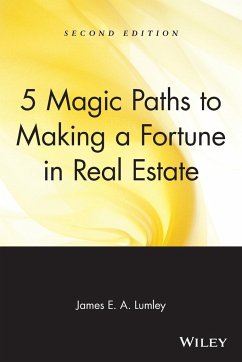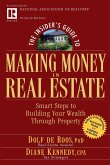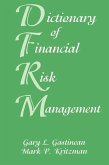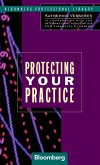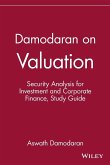James E a Lumley
5 Magic Paths to Making a Fortune in Real Estate
29,99 €
inkl. MwSt.
Versandfertig in über 4 Wochen

15 °P sammeln
James E a Lumley
5 Magic Paths to Making a Fortune in Real Estate
- Broschiertes Buch
- Merkliste
- Auf die Merkliste
- Bewerten Bewerten
- Teilen
- Produkt teilen
- Produkterinnerung
- Produkterinnerung
A new and revised edition of the commonsense guide to real estate riches More and more people are discovering that real estate investing is a safe and affordable way to increase their cash flow and build lasting wealth. If you want to achieve financial freedom, then look no further. 5 Magic Paths to Making a Fortune in Real Estate reveals the proven real estate investment strategies that many of today's millionaires used to make their fortunes. In fact, you don't even need a lot of money to start investing and start putting cash in your pocket today! Real estate expert James Lumley offers…mehr
Andere Kunden interessierten sich auch für
![Dictionary of Real Estate Dictionary of Real Estate]() Jae K ShimDictionary of Real Estate34,99 €
Jae K ShimDictionary of Real Estate34,99 €![The Insider's Guide to Making Money in Real Estate The Insider's Guide to Making Money in Real Estate]() Dolf De RoosThe Insider's Guide to Making Money in Real Estate22,99 €
Dolf De RoosThe Insider's Guide to Making Money in Real Estate22,99 €![Wheels of Fortune Wheels of Fortune]() Charles R GeisstWheels of Fortune22,99 €
Charles R GeisstWheels of Fortune22,99 €![Dictionary of Financial Risk Management Dictionary of Financial Risk Management]() Gary L GastineauDictionary of Financial Risk Management49,99 €
Gary L GastineauDictionary of Financial Risk Management49,99 €![Only Yesterday Only Yesterday]() Frederick Lewis AllenOnly Yesterday34,99 €
Frederick Lewis AllenOnly Yesterday34,99 €![Protecting Your Practice Protecting Your Practice]() Katherine VessenesProtecting Your Practice54,99 €
Katherine VessenesProtecting Your Practice54,99 €![Damodaran on Valuation, Study Guide Damodaran on Valuation, Study Guide]() Aswath DamodaranDamodaran on Valuation, Study Guide49,99 €
Aswath DamodaranDamodaran on Valuation, Study Guide49,99 €-
-
-
A new and revised edition of the commonsense guide to real estate riches More and more people are discovering that real estate investing is a safe and affordable way to increase their cash flow and build lasting wealth. If you want to achieve financial freedom, then look no further. 5 Magic Paths to Making a Fortune in Real Estate reveals the proven real estate investment strategies that many of today's millionaires used to make their fortunes. In fact, you don't even need a lot of money to start investing and start putting cash in your pocket today! Real estate expert James Lumley offers simple, straightforward explanations of the most common and lucrative approaches to property investment--including fixer-uppers, lease/options, wholesales, buy-and-hold, and single-and multifamily rentals. You'll understand all the basics of real estate and learn to use these five strategies to make a killing in any economy. Packed with new information--including sections on the IRS's simplified tax exchange rules and the capital gains exclusion--5 Magic Paths to Making a Fortune in Real Estate will show you how to: * Find foreclosed, repossessed, or condemned properties * Research the markets and perform valuations * Determine what you can safely afford * Negotiate with sellers and buyers * Find the best financing terms, including seller financing * Price and perform money-making repairs * Work with agents and contractors * And much more!
Hinweis: Dieser Artikel kann nur an eine deutsche Lieferadresse ausgeliefert werden.
Hinweis: Dieser Artikel kann nur an eine deutsche Lieferadresse ausgeliefert werden.
Produktdetails
- Produktdetails
- Verlag: Wiley
- 2nd edition
- Seitenzahl: 336
- Erscheinungstermin: 21. Mai 2004
- Englisch
- Abmessung: 229mm x 152mm x 20mm
- Gewicht: 553g
- ISBN-13: 9780471548256
- ISBN-10: 0471548251
- Artikelnr.: 21729115
- Herstellerkennzeichnung
- Libri GmbH
- Europaallee 1
- 36244 Bad Hersfeld
- gpsr@libri.de
- Verlag: Wiley
- 2nd edition
- Seitenzahl: 336
- Erscheinungstermin: 21. Mai 2004
- Englisch
- Abmessung: 229mm x 152mm x 20mm
- Gewicht: 553g
- ISBN-13: 9780471548256
- ISBN-10: 0471548251
- Artikelnr.: 21729115
- Herstellerkennzeichnung
- Libri GmbH
- Europaallee 1
- 36244 Bad Hersfeld
- gpsr@libri.de
JAMES E. A. LUMLEY is a real estate broker with more than thirty-five years of experience as a real estate salesperson, consultant, and educator. He is also the author of How to Get a Mortgage in 24 Hours and Challenge Your Taxes, both from Wiley.
Preface xiii
Acknowledgments xv
Introduction xvii
Introduction to the Second Edition xxi
CHAPTER 1 Five Magic Paths to Making a Fortune in Real Estate 1
The Five Magic Ways to Wealth 1
Now It's Time to Make Real Money 5
Guidelines for Getting Started 6
Combine Techniques to Ensure Success 6
Before You Roll Up Your Sleeves 7
Take Some Measurements of Your Market 8
Magic Paths FAQs 9
CHAPTER 2 Making Money with Fixer-Uppers 12
The Fix-Up-and-Sell Strategy 12
Buying a Fixer-Upper 13
Seek Fixer-Uppers in All Price Levels 15
You May Wish to Live in Your Investment 16
Eight-Point Checklist for Making Money with Fixer-Uppers 17
Some Bargaining Ideas 19
Rehabbing: Frequently Asked Questions 20
CHAPTER 3 Finding the Fixer-Upper Bargain 25
Mining for Gold: Target a Neighborhood 25
Find Sellers with Neglected Properties 27
Screen the Seller's Motivation-Using the Telephone to Advantage 28
Ways to Find Sellers 30
Don't Overlook Out-of-State Owners 33
You're Ready to Meet the Seller at the Property 33
Seek Houses through MLS or the Internet 34
Get Agents to Bird Dog Property for You 37
Have a Contact System for Agents and Prospects 37
When You're Offered a Group of Houses 38
It's All about Prospecting 39
CHAPTER 4 Finding Foreclosed, Repossessed, or Condemned Property 40
The Perils and Rewards of Buying at Foreclosure 40
Finding Properties before Actual Foreclosure 42
Step In and Negotiate before the Foreclosure 43
Solving the Problems of a Homeowner Facing Foreclosure 43
Taking Over a Qualifying Foreclosure 44
Getting Started with Your First Auction Foreclosure 45
Deciding Whether a Deal Is Good 46
Some Reminders on Foreclosures 48
When the IRS Has a Lien on Property Being Foreclosed 48
Get Acquainted with Auction Procedure 49
Getting an REO from the Bank 50
Use Your Repair Estimate to Drive the Price Down 51
Find Condemned Houses in Respectable Neighborhoods 54
CHAPTER 5 Repairs That Make You the Most Money 57
Start by Getting Accurate Estimates 58
Four Broad Areas of Repairs 58
Six Major Areas of Inspection and Repair 59
From Preliminary Outline to Finalized List 60
A First Priority: Arranging Time for the Repair Estimation 64
Early Inspections Avoid Problems Later 64
Typical Repairs You May Encounter 65
What Repairs to Avoid 66
Always Solve Code Violations 66
Getting to Know the Bricks and Mortar, or, The More You Know, the More
You'll Earn 67
Special Problem of Dealing with a Cracked Foundation 69
Another Common Rehab Problem: Fire Damage 72
Six-Point Checklist for Fixing Up 72
CHAPTER 6 Valuing Properties Is the Key to Profits 74
Judging the "After Repairs" Value 74
Repair Costs Lead to Finding Value 75
Getting Started in Valuing Houses 76
You Start by Finding Comparable Properties with Recent Sales 77
Doing a Mini-Appraisal 78
What to Consider in Determining Value 79
Making Adjustments to Equalize Value 80
Features to Adjust in the Mini-Appraisal 83
Pricing Adjustments Accurately Improves with Experience 85
Make Sure Comparable Sales Are Arm's-Length Transactions 85
Neighborhood Prices Tend to Cluster 86
CHAPTER 7 Negotiate to Get Your Offers Accepted 87
How Much Profit Do You Take? 87
How to Determine Maximum Offer Price 89
Now That You Know Your Limit, Where Do You Start? 91
Use Repair Costs to Convince the Seller 94
Be Ready to Walk Away If No Solution 97
Make Offers on a Regular Basis 97
Seven-Point Strategy to Get Your Offers Approved 98
Always Use "Contingent on Financing" Clause 101
CHAPTER 8 Wholesale Property for Steady Gains 103
What Are the Basics of Wholesaling, or Flipping, a Property? 103
Getting Started with Wholesaling 104
Advice for a Newbie! 107
Searching for a Property to Flip 108
To Whom Do You Wholesale? 109
Run an Ad to Attract Investor-Buyers 110
Make Sure Your Wholesale Buyers Have Cash or Credit Line 110
Finding Cash Buyers for Wholesale Property 111
It's All about Establishing Relationships 112
Why a 3% to 8% Profit in Wholesaling Fixer-Uppers? 113
Contract Provisions for Wholesaling 113
Using Two Contracts to Separate Seller and Buyer 115
Problems and Solutions in Wholesaling 116
CHAPTER 9 Financing I:Working through Conventional Lenders 119
The Differences between Home and Investment Mortgages 119
Down Payment and Closing Costs 120
Shop for Mortgage Loans 120
What Types of Mortgages Are Available? 121
Comparing Different Mortgages 122
Two Ways to Qualify for Fixed Rate Loans 123
Second Mortgage Financing from a Conventional Lender 123
Cash from a Home Equity Credit Line 126
Be Prudent in Risking the Equity in Your Home 129
Using a Blanket Mortgage to Cover the Down Payment 129
Consider a Construction Loan to Finance Repairs 130
Credit with a Commercial Bank Is Better than Gold 131
Rehabbing through the FHA 203(k) Loan 131
Fannie Mae HomeStyle Loan 135
CHAPTER 10 Financing II: Help from the Seller 136
Secondary Financing from the Seller 136
Seller Financing with Second Mortgage 137
When Seller Financing Is All That's Available 138
What "No Money Down" Really Means 138
Buying "Subject to" and "Assuming" an Existing Mortgage 139
Problems of Buying "Subject to" 141
Takeover with Management Agreement and Escrowed Deed 143
Using a Land Trust 143
Using Credit Cards to Help with Down Payment 144
Word of Warning 145
Title I Loan Guarantee 145
Questions and Answers on Financing 146
A Final Note 148
CHAPTER 11 Lease/Options I: Arranging Rent-to-Own with Tenant-Buyers 150
Be a Matchmaker 152
Owner's Reasons to Participate in Lease/Option Are Varied 155
Make the Lease/Option Appeal to the Seller 155
Making a Lease/Option Offer 156
Doing the Typical Lease/Option Deal 158
Your First Lease/Option Deal 161
Making Sure You've Got a Great Deal 162
Five Ways to Find Tenant-Buyers 165
Use a Lease/Option to Take a House with Little Equity 166
A Final Note: Keep a Working Relationship with Your Agent 167
CHAPTER 12 Lease/Options II: Arranging Contracts and Closings with
Tenant-Buyers 168
Structuring a Safe Lease/Option 168
Advanced Techniques-Use Lease/Purchase/Option to Sell Fixer-Uppers for Best
Price 169
What Is the Difference between an Option and an Agreement to Purchase? 172
What Should Be in Lease/Option and Lease/Purchase Agreements 174
Keep Your Right to Assign Contract with Owner 176
Whom Do You Make Responsible for Repairs? 177
When Your Tenant-Buyer Wants to Change the Terms 177
Making Sure the Lender Accepts Rent Credits 178
Does a Lease/Option Trigger a Due-on-Sale Clause in the Mortgage? 179
Working Out a Simultaneous Closing 180
With Sellers You've Got More than One Arrow in Your Quiver 181
CHAPTER 13 Buy-and-Hold I: The Single-Family 182
Buy and Sell, or Buy and Hold 182
The Buy-and-Hold Strategy 183
Buying and Renting Out the Single-Family 183
Using Quick Ratios to Value the Single-Family Rental 184
The Five Tools That Lead to Wealth 187
A Capital Gains Tax Review 189
Maintaining Investor Status with the IRS 190
Exchange of Property to Preserve Long-Term Gains 191
One Indispensable Tool-The Financial Calculator 192
Example A: The Time Value of Money 193
Example B: Accumulated Interest and Loan Balance after a Specified Payment
195
Example C: Buying a Rental House 195
The Present Value of an Investment 197
CHAPTER 14 Buy-and-Hold II: The Multifamily 198
Why the Multifamily Is a Great Long-Term Investment 198
Target Properties That Throw Off Cash 200
Create an Accurate Income and Expense Statement 201
Start by Researching Rents, Vacancy Rate, and Expenses 201
Net Operating Income Is Basis for Establishing Value 208
Working with the Capitalization Rate 208
Cap Rate Is a Function of Building's Age and Condition 210
CHAPTER 15 Finding the Value of an Income Property 213
A First Deal: Using Cap Rate to Peg Value 213
You Really Want to Know How Much Cash Is Left Over 217
Valuing Future Income-Discounted Cash Flow Analysis 217
Discounting Cash Flow after Financing 219
Internal Rate of Return 221
Depreciation and Interest Deductions Determine Your Taxable Income 223
Your Cash Flow after Taxes 226
CHAPTER 16 Making the Offer on the Multifamily 228
Beware of Gross Rent Multiplier 228
Using the Capitalization Rate to Know What to Offer 229
Again, Once You Decide to Buy, Make Two Offers 230
Deciding to Buy or Not to Buy 232
If It's Not Worth Selling, It's Not Worth Buying 236
Raising Rents Leads to More Value 243
Working with Agents on Multiunit Deals 244
CHAPTER 17 Financing the Multifamily 247
Cash and Skills Help Gain a Conventional Loan 247
Knowing the Lender's Guideline-The Debt Coverage Ratio 248
Getting the Seller to Finance 249
After a Conventional Lender Takes the First Mortgage 249
Tax Law Promotes Seller Financing with an Installment Sale 250
Using a Land Contract to Bypass the Bank 254
Take Over a Large Mortgage 255
How Long Do You Want Your Mortgage to Run? 257
Accelerated Mortgage Payments in Perspective 258
Some Financing Guidelines 259
More Creative Techniques to Make a Deal Work 260
The Roth IRA 263
When Taking In a Partner Can Make More Profit 264
CHAPTER 18 Managing Your Property 266
First Time Out: Be Your Own Landlord 266
What a Property Manager Does 267
Getting Good Tenants 269
A Landlord's Primer 269
When All Else Fails: Removing Late-Paying Tenants 273
On Looking for a Good Property Management Company 276
Your Liability as a Landlord 276
Limit Your Loan Liability to the Property 277
Should You Form a Corporation or Limited Partnership? 278
CHAPTER 19 The Magic Formula for Success: Use Flexible Strategies 279
Be Flexible-Profit with Different Strategies 279
Choose the Best Technique to Create Wealth 280
Before the Finish-Use an Attorney 281
Plan Ahead to Reduce the Risks of Real Estate 282
Knowledge Gives You Confidence 282
Let People Know You Deal in Property 283
Work Hard to Become Known 283
CHAPTER 20 How You Benefit from the New Tax Law 285
Recent Tax Laws Keep Dollars in Your Pocket 285
Sheltering Taxable Gains from Your Home 286
Using the Gain Exclusion with Multiple Residences 288
Tax Rules for Second-Home Ownership 289
Should You Turn Your Own Home into an Investment Property or Sell It? 291
Are You a Dealer or an Investor? 293
The Tax-Deferred "Starker" Exchange 295
Combining the "Exchange" with the "Exclusion" 299
A Final Note 300
EPILOGUE Success Is Not about Education, or Even Hard Work-It's about
Following Through 302
TIPS TO REMEMBER 303
FINAL THOUGHTS 305
Index 307
Acknowledgments xv
Introduction xvii
Introduction to the Second Edition xxi
CHAPTER 1 Five Magic Paths to Making a Fortune in Real Estate 1
The Five Magic Ways to Wealth 1
Now It's Time to Make Real Money 5
Guidelines for Getting Started 6
Combine Techniques to Ensure Success 6
Before You Roll Up Your Sleeves 7
Take Some Measurements of Your Market 8
Magic Paths FAQs 9
CHAPTER 2 Making Money with Fixer-Uppers 12
The Fix-Up-and-Sell Strategy 12
Buying a Fixer-Upper 13
Seek Fixer-Uppers in All Price Levels 15
You May Wish to Live in Your Investment 16
Eight-Point Checklist for Making Money with Fixer-Uppers 17
Some Bargaining Ideas 19
Rehabbing: Frequently Asked Questions 20
CHAPTER 3 Finding the Fixer-Upper Bargain 25
Mining for Gold: Target a Neighborhood 25
Find Sellers with Neglected Properties 27
Screen the Seller's Motivation-Using the Telephone to Advantage 28
Ways to Find Sellers 30
Don't Overlook Out-of-State Owners 33
You're Ready to Meet the Seller at the Property 33
Seek Houses through MLS or the Internet 34
Get Agents to Bird Dog Property for You 37
Have a Contact System for Agents and Prospects 37
When You're Offered a Group of Houses 38
It's All about Prospecting 39
CHAPTER 4 Finding Foreclosed, Repossessed, or Condemned Property 40
The Perils and Rewards of Buying at Foreclosure 40
Finding Properties before Actual Foreclosure 42
Step In and Negotiate before the Foreclosure 43
Solving the Problems of a Homeowner Facing Foreclosure 43
Taking Over a Qualifying Foreclosure 44
Getting Started with Your First Auction Foreclosure 45
Deciding Whether a Deal Is Good 46
Some Reminders on Foreclosures 48
When the IRS Has a Lien on Property Being Foreclosed 48
Get Acquainted with Auction Procedure 49
Getting an REO from the Bank 50
Use Your Repair Estimate to Drive the Price Down 51
Find Condemned Houses in Respectable Neighborhoods 54
CHAPTER 5 Repairs That Make You the Most Money 57
Start by Getting Accurate Estimates 58
Four Broad Areas of Repairs 58
Six Major Areas of Inspection and Repair 59
From Preliminary Outline to Finalized List 60
A First Priority: Arranging Time for the Repair Estimation 64
Early Inspections Avoid Problems Later 64
Typical Repairs You May Encounter 65
What Repairs to Avoid 66
Always Solve Code Violations 66
Getting to Know the Bricks and Mortar, or, The More You Know, the More
You'll Earn 67
Special Problem of Dealing with a Cracked Foundation 69
Another Common Rehab Problem: Fire Damage 72
Six-Point Checklist for Fixing Up 72
CHAPTER 6 Valuing Properties Is the Key to Profits 74
Judging the "After Repairs" Value 74
Repair Costs Lead to Finding Value 75
Getting Started in Valuing Houses 76
You Start by Finding Comparable Properties with Recent Sales 77
Doing a Mini-Appraisal 78
What to Consider in Determining Value 79
Making Adjustments to Equalize Value 80
Features to Adjust in the Mini-Appraisal 83
Pricing Adjustments Accurately Improves with Experience 85
Make Sure Comparable Sales Are Arm's-Length Transactions 85
Neighborhood Prices Tend to Cluster 86
CHAPTER 7 Negotiate to Get Your Offers Accepted 87
How Much Profit Do You Take? 87
How to Determine Maximum Offer Price 89
Now That You Know Your Limit, Where Do You Start? 91
Use Repair Costs to Convince the Seller 94
Be Ready to Walk Away If No Solution 97
Make Offers on a Regular Basis 97
Seven-Point Strategy to Get Your Offers Approved 98
Always Use "Contingent on Financing" Clause 101
CHAPTER 8 Wholesale Property for Steady Gains 103
What Are the Basics of Wholesaling, or Flipping, a Property? 103
Getting Started with Wholesaling 104
Advice for a Newbie! 107
Searching for a Property to Flip 108
To Whom Do You Wholesale? 109
Run an Ad to Attract Investor-Buyers 110
Make Sure Your Wholesale Buyers Have Cash or Credit Line 110
Finding Cash Buyers for Wholesale Property 111
It's All about Establishing Relationships 112
Why a 3% to 8% Profit in Wholesaling Fixer-Uppers? 113
Contract Provisions for Wholesaling 113
Using Two Contracts to Separate Seller and Buyer 115
Problems and Solutions in Wholesaling 116
CHAPTER 9 Financing I:Working through Conventional Lenders 119
The Differences between Home and Investment Mortgages 119
Down Payment and Closing Costs 120
Shop for Mortgage Loans 120
What Types of Mortgages Are Available? 121
Comparing Different Mortgages 122
Two Ways to Qualify for Fixed Rate Loans 123
Second Mortgage Financing from a Conventional Lender 123
Cash from a Home Equity Credit Line 126
Be Prudent in Risking the Equity in Your Home 129
Using a Blanket Mortgage to Cover the Down Payment 129
Consider a Construction Loan to Finance Repairs 130
Credit with a Commercial Bank Is Better than Gold 131
Rehabbing through the FHA 203(k) Loan 131
Fannie Mae HomeStyle Loan 135
CHAPTER 10 Financing II: Help from the Seller 136
Secondary Financing from the Seller 136
Seller Financing with Second Mortgage 137
When Seller Financing Is All That's Available 138
What "No Money Down" Really Means 138
Buying "Subject to" and "Assuming" an Existing Mortgage 139
Problems of Buying "Subject to" 141
Takeover with Management Agreement and Escrowed Deed 143
Using a Land Trust 143
Using Credit Cards to Help with Down Payment 144
Word of Warning 145
Title I Loan Guarantee 145
Questions and Answers on Financing 146
A Final Note 148
CHAPTER 11 Lease/Options I: Arranging Rent-to-Own with Tenant-Buyers 150
Be a Matchmaker 152
Owner's Reasons to Participate in Lease/Option Are Varied 155
Make the Lease/Option Appeal to the Seller 155
Making a Lease/Option Offer 156
Doing the Typical Lease/Option Deal 158
Your First Lease/Option Deal 161
Making Sure You've Got a Great Deal 162
Five Ways to Find Tenant-Buyers 165
Use a Lease/Option to Take a House with Little Equity 166
A Final Note: Keep a Working Relationship with Your Agent 167
CHAPTER 12 Lease/Options II: Arranging Contracts and Closings with
Tenant-Buyers 168
Structuring a Safe Lease/Option 168
Advanced Techniques-Use Lease/Purchase/Option to Sell Fixer-Uppers for Best
Price 169
What Is the Difference between an Option and an Agreement to Purchase? 172
What Should Be in Lease/Option and Lease/Purchase Agreements 174
Keep Your Right to Assign Contract with Owner 176
Whom Do You Make Responsible for Repairs? 177
When Your Tenant-Buyer Wants to Change the Terms 177
Making Sure the Lender Accepts Rent Credits 178
Does a Lease/Option Trigger a Due-on-Sale Clause in the Mortgage? 179
Working Out a Simultaneous Closing 180
With Sellers You've Got More than One Arrow in Your Quiver 181
CHAPTER 13 Buy-and-Hold I: The Single-Family 182
Buy and Sell, or Buy and Hold 182
The Buy-and-Hold Strategy 183
Buying and Renting Out the Single-Family 183
Using Quick Ratios to Value the Single-Family Rental 184
The Five Tools That Lead to Wealth 187
A Capital Gains Tax Review 189
Maintaining Investor Status with the IRS 190
Exchange of Property to Preserve Long-Term Gains 191
One Indispensable Tool-The Financial Calculator 192
Example A: The Time Value of Money 193
Example B: Accumulated Interest and Loan Balance after a Specified Payment
195
Example C: Buying a Rental House 195
The Present Value of an Investment 197
CHAPTER 14 Buy-and-Hold II: The Multifamily 198
Why the Multifamily Is a Great Long-Term Investment 198
Target Properties That Throw Off Cash 200
Create an Accurate Income and Expense Statement 201
Start by Researching Rents, Vacancy Rate, and Expenses 201
Net Operating Income Is Basis for Establishing Value 208
Working with the Capitalization Rate 208
Cap Rate Is a Function of Building's Age and Condition 210
CHAPTER 15 Finding the Value of an Income Property 213
A First Deal: Using Cap Rate to Peg Value 213
You Really Want to Know How Much Cash Is Left Over 217
Valuing Future Income-Discounted Cash Flow Analysis 217
Discounting Cash Flow after Financing 219
Internal Rate of Return 221
Depreciation and Interest Deductions Determine Your Taxable Income 223
Your Cash Flow after Taxes 226
CHAPTER 16 Making the Offer on the Multifamily 228
Beware of Gross Rent Multiplier 228
Using the Capitalization Rate to Know What to Offer 229
Again, Once You Decide to Buy, Make Two Offers 230
Deciding to Buy or Not to Buy 232
If It's Not Worth Selling, It's Not Worth Buying 236
Raising Rents Leads to More Value 243
Working with Agents on Multiunit Deals 244
CHAPTER 17 Financing the Multifamily 247
Cash and Skills Help Gain a Conventional Loan 247
Knowing the Lender's Guideline-The Debt Coverage Ratio 248
Getting the Seller to Finance 249
After a Conventional Lender Takes the First Mortgage 249
Tax Law Promotes Seller Financing with an Installment Sale 250
Using a Land Contract to Bypass the Bank 254
Take Over a Large Mortgage 255
How Long Do You Want Your Mortgage to Run? 257
Accelerated Mortgage Payments in Perspective 258
Some Financing Guidelines 259
More Creative Techniques to Make a Deal Work 260
The Roth IRA 263
When Taking In a Partner Can Make More Profit 264
CHAPTER 18 Managing Your Property 266
First Time Out: Be Your Own Landlord 266
What a Property Manager Does 267
Getting Good Tenants 269
A Landlord's Primer 269
When All Else Fails: Removing Late-Paying Tenants 273
On Looking for a Good Property Management Company 276
Your Liability as a Landlord 276
Limit Your Loan Liability to the Property 277
Should You Form a Corporation or Limited Partnership? 278
CHAPTER 19 The Magic Formula for Success: Use Flexible Strategies 279
Be Flexible-Profit with Different Strategies 279
Choose the Best Technique to Create Wealth 280
Before the Finish-Use an Attorney 281
Plan Ahead to Reduce the Risks of Real Estate 282
Knowledge Gives You Confidence 282
Let People Know You Deal in Property 283
Work Hard to Become Known 283
CHAPTER 20 How You Benefit from the New Tax Law 285
Recent Tax Laws Keep Dollars in Your Pocket 285
Sheltering Taxable Gains from Your Home 286
Using the Gain Exclusion with Multiple Residences 288
Tax Rules for Second-Home Ownership 289
Should You Turn Your Own Home into an Investment Property or Sell It? 291
Are You a Dealer or an Investor? 293
The Tax-Deferred "Starker" Exchange 295
Combining the "Exchange" with the "Exclusion" 299
A Final Note 300
EPILOGUE Success Is Not about Education, or Even Hard Work-It's about
Following Through 302
TIPS TO REMEMBER 303
FINAL THOUGHTS 305
Index 307
Preface xiii
Acknowledgments xv
Introduction xvii
Introduction to the Second Edition xxi
CHAPTER 1 Five Magic Paths to Making a Fortune in Real Estate 1
The Five Magic Ways to Wealth 1
Now It's Time to Make Real Money 5
Guidelines for Getting Started 6
Combine Techniques to Ensure Success 6
Before You Roll Up Your Sleeves 7
Take Some Measurements of Your Market 8
Magic Paths FAQs 9
CHAPTER 2 Making Money with Fixer-Uppers 12
The Fix-Up-and-Sell Strategy 12
Buying a Fixer-Upper 13
Seek Fixer-Uppers in All Price Levels 15
You May Wish to Live in Your Investment 16
Eight-Point Checklist for Making Money with Fixer-Uppers 17
Some Bargaining Ideas 19
Rehabbing: Frequently Asked Questions 20
CHAPTER 3 Finding the Fixer-Upper Bargain 25
Mining for Gold: Target a Neighborhood 25
Find Sellers with Neglected Properties 27
Screen the Seller's Motivation-Using the Telephone to Advantage 28
Ways to Find Sellers 30
Don't Overlook Out-of-State Owners 33
You're Ready to Meet the Seller at the Property 33
Seek Houses through MLS or the Internet 34
Get Agents to Bird Dog Property for You 37
Have a Contact System for Agents and Prospects 37
When You're Offered a Group of Houses 38
It's All about Prospecting 39
CHAPTER 4 Finding Foreclosed, Repossessed, or Condemned Property 40
The Perils and Rewards of Buying at Foreclosure 40
Finding Properties before Actual Foreclosure 42
Step In and Negotiate before the Foreclosure 43
Solving the Problems of a Homeowner Facing Foreclosure 43
Taking Over a Qualifying Foreclosure 44
Getting Started with Your First Auction Foreclosure 45
Deciding Whether a Deal Is Good 46
Some Reminders on Foreclosures 48
When the IRS Has a Lien on Property Being Foreclosed 48
Get Acquainted with Auction Procedure 49
Getting an REO from the Bank 50
Use Your Repair Estimate to Drive the Price Down 51
Find Condemned Houses in Respectable Neighborhoods 54
CHAPTER 5 Repairs That Make You the Most Money 57
Start by Getting Accurate Estimates 58
Four Broad Areas of Repairs 58
Six Major Areas of Inspection and Repair 59
From Preliminary Outline to Finalized List 60
A First Priority: Arranging Time for the Repair Estimation 64
Early Inspections Avoid Problems Later 64
Typical Repairs You May Encounter 65
What Repairs to Avoid 66
Always Solve Code Violations 66
Getting to Know the Bricks and Mortar, or, The More You Know, the More
You'll Earn 67
Special Problem of Dealing with a Cracked Foundation 69
Another Common Rehab Problem: Fire Damage 72
Six-Point Checklist for Fixing Up 72
CHAPTER 6 Valuing Properties Is the Key to Profits 74
Judging the "After Repairs" Value 74
Repair Costs Lead to Finding Value 75
Getting Started in Valuing Houses 76
You Start by Finding Comparable Properties with Recent Sales 77
Doing a Mini-Appraisal 78
What to Consider in Determining Value 79
Making Adjustments to Equalize Value 80
Features to Adjust in the Mini-Appraisal 83
Pricing Adjustments Accurately Improves with Experience 85
Make Sure Comparable Sales Are Arm's-Length Transactions 85
Neighborhood Prices Tend to Cluster 86
CHAPTER 7 Negotiate to Get Your Offers Accepted 87
How Much Profit Do You Take? 87
How to Determine Maximum Offer Price 89
Now That You Know Your Limit, Where Do You Start? 91
Use Repair Costs to Convince the Seller 94
Be Ready to Walk Away If No Solution 97
Make Offers on a Regular Basis 97
Seven-Point Strategy to Get Your Offers Approved 98
Always Use "Contingent on Financing" Clause 101
CHAPTER 8 Wholesale Property for Steady Gains 103
What Are the Basics of Wholesaling, or Flipping, a Property? 103
Getting Started with Wholesaling 104
Advice for a Newbie! 107
Searching for a Property to Flip 108
To Whom Do You Wholesale? 109
Run an Ad to Attract Investor-Buyers 110
Make Sure Your Wholesale Buyers Have Cash or Credit Line 110
Finding Cash Buyers for Wholesale Property 111
It's All about Establishing Relationships 112
Why a 3% to 8% Profit in Wholesaling Fixer-Uppers? 113
Contract Provisions for Wholesaling 113
Using Two Contracts to Separate Seller and Buyer 115
Problems and Solutions in Wholesaling 116
CHAPTER 9 Financing I:Working through Conventional Lenders 119
The Differences between Home and Investment Mortgages 119
Down Payment and Closing Costs 120
Shop for Mortgage Loans 120
What Types of Mortgages Are Available? 121
Comparing Different Mortgages 122
Two Ways to Qualify for Fixed Rate Loans 123
Second Mortgage Financing from a Conventional Lender 123
Cash from a Home Equity Credit Line 126
Be Prudent in Risking the Equity in Your Home 129
Using a Blanket Mortgage to Cover the Down Payment 129
Consider a Construction Loan to Finance Repairs 130
Credit with a Commercial Bank Is Better than Gold 131
Rehabbing through the FHA 203(k) Loan 131
Fannie Mae HomeStyle Loan 135
CHAPTER 10 Financing II: Help from the Seller 136
Secondary Financing from the Seller 136
Seller Financing with Second Mortgage 137
When Seller Financing Is All That's Available 138
What "No Money Down" Really Means 138
Buying "Subject to" and "Assuming" an Existing Mortgage 139
Problems of Buying "Subject to" 141
Takeover with Management Agreement and Escrowed Deed 143
Using a Land Trust 143
Using Credit Cards to Help with Down Payment 144
Word of Warning 145
Title I Loan Guarantee 145
Questions and Answers on Financing 146
A Final Note 148
CHAPTER 11 Lease/Options I: Arranging Rent-to-Own with Tenant-Buyers 150
Be a Matchmaker 152
Owner's Reasons to Participate in Lease/Option Are Varied 155
Make the Lease/Option Appeal to the Seller 155
Making a Lease/Option Offer 156
Doing the Typical Lease/Option Deal 158
Your First Lease/Option Deal 161
Making Sure You've Got a Great Deal 162
Five Ways to Find Tenant-Buyers 165
Use a Lease/Option to Take a House with Little Equity 166
A Final Note: Keep a Working Relationship with Your Agent 167
CHAPTER 12 Lease/Options II: Arranging Contracts and Closings with
Tenant-Buyers 168
Structuring a Safe Lease/Option 168
Advanced Techniques-Use Lease/Purchase/Option to Sell Fixer-Uppers for Best
Price 169
What Is the Difference between an Option and an Agreement to Purchase? 172
What Should Be in Lease/Option and Lease/Purchase Agreements 174
Keep Your Right to Assign Contract with Owner 176
Whom Do You Make Responsible for Repairs? 177
When Your Tenant-Buyer Wants to Change the Terms 177
Making Sure the Lender Accepts Rent Credits 178
Does a Lease/Option Trigger a Due-on-Sale Clause in the Mortgage? 179
Working Out a Simultaneous Closing 180
With Sellers You've Got More than One Arrow in Your Quiver 181
CHAPTER 13 Buy-and-Hold I: The Single-Family 182
Buy and Sell, or Buy and Hold 182
The Buy-and-Hold Strategy 183
Buying and Renting Out the Single-Family 183
Using Quick Ratios to Value the Single-Family Rental 184
The Five Tools That Lead to Wealth 187
A Capital Gains Tax Review 189
Maintaining Investor Status with the IRS 190
Exchange of Property to Preserve Long-Term Gains 191
One Indispensable Tool-The Financial Calculator 192
Example A: The Time Value of Money 193
Example B: Accumulated Interest and Loan Balance after a Specified Payment
195
Example C: Buying a Rental House 195
The Present Value of an Investment 197
CHAPTER 14 Buy-and-Hold II: The Multifamily 198
Why the Multifamily Is a Great Long-Term Investment 198
Target Properties That Throw Off Cash 200
Create an Accurate Income and Expense Statement 201
Start by Researching Rents, Vacancy Rate, and Expenses 201
Net Operating Income Is Basis for Establishing Value 208
Working with the Capitalization Rate 208
Cap Rate Is a Function of Building's Age and Condition 210
CHAPTER 15 Finding the Value of an Income Property 213
A First Deal: Using Cap Rate to Peg Value 213
You Really Want to Know How Much Cash Is Left Over 217
Valuing Future Income-Discounted Cash Flow Analysis 217
Discounting Cash Flow after Financing 219
Internal Rate of Return 221
Depreciation and Interest Deductions Determine Your Taxable Income 223
Your Cash Flow after Taxes 226
CHAPTER 16 Making the Offer on the Multifamily 228
Beware of Gross Rent Multiplier 228
Using the Capitalization Rate to Know What to Offer 229
Again, Once You Decide to Buy, Make Two Offers 230
Deciding to Buy or Not to Buy 232
If It's Not Worth Selling, It's Not Worth Buying 236
Raising Rents Leads to More Value 243
Working with Agents on Multiunit Deals 244
CHAPTER 17 Financing the Multifamily 247
Cash and Skills Help Gain a Conventional Loan 247
Knowing the Lender's Guideline-The Debt Coverage Ratio 248
Getting the Seller to Finance 249
After a Conventional Lender Takes the First Mortgage 249
Tax Law Promotes Seller Financing with an Installment Sale 250
Using a Land Contract to Bypass the Bank 254
Take Over a Large Mortgage 255
How Long Do You Want Your Mortgage to Run? 257
Accelerated Mortgage Payments in Perspective 258
Some Financing Guidelines 259
More Creative Techniques to Make a Deal Work 260
The Roth IRA 263
When Taking In a Partner Can Make More Profit 264
CHAPTER 18 Managing Your Property 266
First Time Out: Be Your Own Landlord 266
What a Property Manager Does 267
Getting Good Tenants 269
A Landlord's Primer 269
When All Else Fails: Removing Late-Paying Tenants 273
On Looking for a Good Property Management Company 276
Your Liability as a Landlord 276
Limit Your Loan Liability to the Property 277
Should You Form a Corporation or Limited Partnership? 278
CHAPTER 19 The Magic Formula for Success: Use Flexible Strategies 279
Be Flexible-Profit with Different Strategies 279
Choose the Best Technique to Create Wealth 280
Before the Finish-Use an Attorney 281
Plan Ahead to Reduce the Risks of Real Estate 282
Knowledge Gives You Confidence 282
Let People Know You Deal in Property 283
Work Hard to Become Known 283
CHAPTER 20 How You Benefit from the New Tax Law 285
Recent Tax Laws Keep Dollars in Your Pocket 285
Sheltering Taxable Gains from Your Home 286
Using the Gain Exclusion with Multiple Residences 288
Tax Rules for Second-Home Ownership 289
Should You Turn Your Own Home into an Investment Property or Sell It? 291
Are You a Dealer or an Investor? 293
The Tax-Deferred "Starker" Exchange 295
Combining the "Exchange" with the "Exclusion" 299
A Final Note 300
EPILOGUE Success Is Not about Education, or Even Hard Work-It's about
Following Through 302
TIPS TO REMEMBER 303
FINAL THOUGHTS 305
Index 307
Acknowledgments xv
Introduction xvii
Introduction to the Second Edition xxi
CHAPTER 1 Five Magic Paths to Making a Fortune in Real Estate 1
The Five Magic Ways to Wealth 1
Now It's Time to Make Real Money 5
Guidelines for Getting Started 6
Combine Techniques to Ensure Success 6
Before You Roll Up Your Sleeves 7
Take Some Measurements of Your Market 8
Magic Paths FAQs 9
CHAPTER 2 Making Money with Fixer-Uppers 12
The Fix-Up-and-Sell Strategy 12
Buying a Fixer-Upper 13
Seek Fixer-Uppers in All Price Levels 15
You May Wish to Live in Your Investment 16
Eight-Point Checklist for Making Money with Fixer-Uppers 17
Some Bargaining Ideas 19
Rehabbing: Frequently Asked Questions 20
CHAPTER 3 Finding the Fixer-Upper Bargain 25
Mining for Gold: Target a Neighborhood 25
Find Sellers with Neglected Properties 27
Screen the Seller's Motivation-Using the Telephone to Advantage 28
Ways to Find Sellers 30
Don't Overlook Out-of-State Owners 33
You're Ready to Meet the Seller at the Property 33
Seek Houses through MLS or the Internet 34
Get Agents to Bird Dog Property for You 37
Have a Contact System for Agents and Prospects 37
When You're Offered a Group of Houses 38
It's All about Prospecting 39
CHAPTER 4 Finding Foreclosed, Repossessed, or Condemned Property 40
The Perils and Rewards of Buying at Foreclosure 40
Finding Properties before Actual Foreclosure 42
Step In and Negotiate before the Foreclosure 43
Solving the Problems of a Homeowner Facing Foreclosure 43
Taking Over a Qualifying Foreclosure 44
Getting Started with Your First Auction Foreclosure 45
Deciding Whether a Deal Is Good 46
Some Reminders on Foreclosures 48
When the IRS Has a Lien on Property Being Foreclosed 48
Get Acquainted with Auction Procedure 49
Getting an REO from the Bank 50
Use Your Repair Estimate to Drive the Price Down 51
Find Condemned Houses in Respectable Neighborhoods 54
CHAPTER 5 Repairs That Make You the Most Money 57
Start by Getting Accurate Estimates 58
Four Broad Areas of Repairs 58
Six Major Areas of Inspection and Repair 59
From Preliminary Outline to Finalized List 60
A First Priority: Arranging Time for the Repair Estimation 64
Early Inspections Avoid Problems Later 64
Typical Repairs You May Encounter 65
What Repairs to Avoid 66
Always Solve Code Violations 66
Getting to Know the Bricks and Mortar, or, The More You Know, the More
You'll Earn 67
Special Problem of Dealing with a Cracked Foundation 69
Another Common Rehab Problem: Fire Damage 72
Six-Point Checklist for Fixing Up 72
CHAPTER 6 Valuing Properties Is the Key to Profits 74
Judging the "After Repairs" Value 74
Repair Costs Lead to Finding Value 75
Getting Started in Valuing Houses 76
You Start by Finding Comparable Properties with Recent Sales 77
Doing a Mini-Appraisal 78
What to Consider in Determining Value 79
Making Adjustments to Equalize Value 80
Features to Adjust in the Mini-Appraisal 83
Pricing Adjustments Accurately Improves with Experience 85
Make Sure Comparable Sales Are Arm's-Length Transactions 85
Neighborhood Prices Tend to Cluster 86
CHAPTER 7 Negotiate to Get Your Offers Accepted 87
How Much Profit Do You Take? 87
How to Determine Maximum Offer Price 89
Now That You Know Your Limit, Where Do You Start? 91
Use Repair Costs to Convince the Seller 94
Be Ready to Walk Away If No Solution 97
Make Offers on a Regular Basis 97
Seven-Point Strategy to Get Your Offers Approved 98
Always Use "Contingent on Financing" Clause 101
CHAPTER 8 Wholesale Property for Steady Gains 103
What Are the Basics of Wholesaling, or Flipping, a Property? 103
Getting Started with Wholesaling 104
Advice for a Newbie! 107
Searching for a Property to Flip 108
To Whom Do You Wholesale? 109
Run an Ad to Attract Investor-Buyers 110
Make Sure Your Wholesale Buyers Have Cash or Credit Line 110
Finding Cash Buyers for Wholesale Property 111
It's All about Establishing Relationships 112
Why a 3% to 8% Profit in Wholesaling Fixer-Uppers? 113
Contract Provisions for Wholesaling 113
Using Two Contracts to Separate Seller and Buyer 115
Problems and Solutions in Wholesaling 116
CHAPTER 9 Financing I:Working through Conventional Lenders 119
The Differences between Home and Investment Mortgages 119
Down Payment and Closing Costs 120
Shop for Mortgage Loans 120
What Types of Mortgages Are Available? 121
Comparing Different Mortgages 122
Two Ways to Qualify for Fixed Rate Loans 123
Second Mortgage Financing from a Conventional Lender 123
Cash from a Home Equity Credit Line 126
Be Prudent in Risking the Equity in Your Home 129
Using a Blanket Mortgage to Cover the Down Payment 129
Consider a Construction Loan to Finance Repairs 130
Credit with a Commercial Bank Is Better than Gold 131
Rehabbing through the FHA 203(k) Loan 131
Fannie Mae HomeStyle Loan 135
CHAPTER 10 Financing II: Help from the Seller 136
Secondary Financing from the Seller 136
Seller Financing with Second Mortgage 137
When Seller Financing Is All That's Available 138
What "No Money Down" Really Means 138
Buying "Subject to" and "Assuming" an Existing Mortgage 139
Problems of Buying "Subject to" 141
Takeover with Management Agreement and Escrowed Deed 143
Using a Land Trust 143
Using Credit Cards to Help with Down Payment 144
Word of Warning 145
Title I Loan Guarantee 145
Questions and Answers on Financing 146
A Final Note 148
CHAPTER 11 Lease/Options I: Arranging Rent-to-Own with Tenant-Buyers 150
Be a Matchmaker 152
Owner's Reasons to Participate in Lease/Option Are Varied 155
Make the Lease/Option Appeal to the Seller 155
Making a Lease/Option Offer 156
Doing the Typical Lease/Option Deal 158
Your First Lease/Option Deal 161
Making Sure You've Got a Great Deal 162
Five Ways to Find Tenant-Buyers 165
Use a Lease/Option to Take a House with Little Equity 166
A Final Note: Keep a Working Relationship with Your Agent 167
CHAPTER 12 Lease/Options II: Arranging Contracts and Closings with
Tenant-Buyers 168
Structuring a Safe Lease/Option 168
Advanced Techniques-Use Lease/Purchase/Option to Sell Fixer-Uppers for Best
Price 169
What Is the Difference between an Option and an Agreement to Purchase? 172
What Should Be in Lease/Option and Lease/Purchase Agreements 174
Keep Your Right to Assign Contract with Owner 176
Whom Do You Make Responsible for Repairs? 177
When Your Tenant-Buyer Wants to Change the Terms 177
Making Sure the Lender Accepts Rent Credits 178
Does a Lease/Option Trigger a Due-on-Sale Clause in the Mortgage? 179
Working Out a Simultaneous Closing 180
With Sellers You've Got More than One Arrow in Your Quiver 181
CHAPTER 13 Buy-and-Hold I: The Single-Family 182
Buy and Sell, or Buy and Hold 182
The Buy-and-Hold Strategy 183
Buying and Renting Out the Single-Family 183
Using Quick Ratios to Value the Single-Family Rental 184
The Five Tools That Lead to Wealth 187
A Capital Gains Tax Review 189
Maintaining Investor Status with the IRS 190
Exchange of Property to Preserve Long-Term Gains 191
One Indispensable Tool-The Financial Calculator 192
Example A: The Time Value of Money 193
Example B: Accumulated Interest and Loan Balance after a Specified Payment
195
Example C: Buying a Rental House 195
The Present Value of an Investment 197
CHAPTER 14 Buy-and-Hold II: The Multifamily 198
Why the Multifamily Is a Great Long-Term Investment 198
Target Properties That Throw Off Cash 200
Create an Accurate Income and Expense Statement 201
Start by Researching Rents, Vacancy Rate, and Expenses 201
Net Operating Income Is Basis for Establishing Value 208
Working with the Capitalization Rate 208
Cap Rate Is a Function of Building's Age and Condition 210
CHAPTER 15 Finding the Value of an Income Property 213
A First Deal: Using Cap Rate to Peg Value 213
You Really Want to Know How Much Cash Is Left Over 217
Valuing Future Income-Discounted Cash Flow Analysis 217
Discounting Cash Flow after Financing 219
Internal Rate of Return 221
Depreciation and Interest Deductions Determine Your Taxable Income 223
Your Cash Flow after Taxes 226
CHAPTER 16 Making the Offer on the Multifamily 228
Beware of Gross Rent Multiplier 228
Using the Capitalization Rate to Know What to Offer 229
Again, Once You Decide to Buy, Make Two Offers 230
Deciding to Buy or Not to Buy 232
If It's Not Worth Selling, It's Not Worth Buying 236
Raising Rents Leads to More Value 243
Working with Agents on Multiunit Deals 244
CHAPTER 17 Financing the Multifamily 247
Cash and Skills Help Gain a Conventional Loan 247
Knowing the Lender's Guideline-The Debt Coverage Ratio 248
Getting the Seller to Finance 249
After a Conventional Lender Takes the First Mortgage 249
Tax Law Promotes Seller Financing with an Installment Sale 250
Using a Land Contract to Bypass the Bank 254
Take Over a Large Mortgage 255
How Long Do You Want Your Mortgage to Run? 257
Accelerated Mortgage Payments in Perspective 258
Some Financing Guidelines 259
More Creative Techniques to Make a Deal Work 260
The Roth IRA 263
When Taking In a Partner Can Make More Profit 264
CHAPTER 18 Managing Your Property 266
First Time Out: Be Your Own Landlord 266
What a Property Manager Does 267
Getting Good Tenants 269
A Landlord's Primer 269
When All Else Fails: Removing Late-Paying Tenants 273
On Looking for a Good Property Management Company 276
Your Liability as a Landlord 276
Limit Your Loan Liability to the Property 277
Should You Form a Corporation or Limited Partnership? 278
CHAPTER 19 The Magic Formula for Success: Use Flexible Strategies 279
Be Flexible-Profit with Different Strategies 279
Choose the Best Technique to Create Wealth 280
Before the Finish-Use an Attorney 281
Plan Ahead to Reduce the Risks of Real Estate 282
Knowledge Gives You Confidence 282
Let People Know You Deal in Property 283
Work Hard to Become Known 283
CHAPTER 20 How You Benefit from the New Tax Law 285
Recent Tax Laws Keep Dollars in Your Pocket 285
Sheltering Taxable Gains from Your Home 286
Using the Gain Exclusion with Multiple Residences 288
Tax Rules for Second-Home Ownership 289
Should You Turn Your Own Home into an Investment Property or Sell It? 291
Are You a Dealer or an Investor? 293
The Tax-Deferred "Starker" Exchange 295
Combining the "Exchange" with the "Exclusion" 299
A Final Note 300
EPILOGUE Success Is Not about Education, or Even Hard Work-It's about
Following Through 302
TIPS TO REMEMBER 303
FINAL THOUGHTS 305
Index 307
